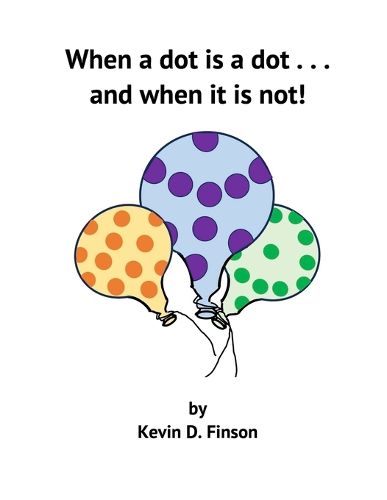Readings Newsletter
Become a Readings Member to make your shopping experience even easier.
Sign in or sign up for free!
You’re not far away from qualifying for FREE standard shipping within Australia
You’ve qualified for FREE standard shipping within Australia
The cart is loading…






This title is printed to order. This book may have been self-published. If so, we cannot guarantee the quality of the content. In the main most books will have gone through the editing process however some may not. We therefore suggest that you be aware of this before ordering this book. If in doubt check either the author or publisher’s details as we are unable to accept any returns unless they are faulty. Please contact us if you have any questions.
When is something a dot, and when is it not a dot? Preschoolers and early elementary age children can have fun exploring that question as they flip through the pages of this book -- either on their own or with the help of someone able to read the short text accompanying each illustration. The illustrations are presented in a way that lends itself to teaching the basic colors (red, orange, yellow, green, blue, purple, black, and white) as well as basic shapes (circle, square, triangle, diamond, star) plus a few others that are not typical. In addition, with some guidance, children can learn about attributes -- or characteristics -- that make something either a dot or not. Most things have more than one attribute. The dots shown in this book have the two attributes of size and color that vary from one illustration to another -- all the while having the same shape. Each attribute can have some variations, called attribute values. The attribute values for dots' colors are the visible spectrum colors plus black and white. The attribute values for dots' size are large, medium, and small. The "not-dot" illustrations differ from dots in their shapes and have their own attribute values. The last few pages of the book provide fun pages that challenge children in identifying what images have dots and which do not. Special notes for parents, teachers, or other interested folks are given at the end to facilitate further learning about attributes.
$9.00 standard shipping within Australia
FREE standard shipping within Australia for orders over $100.00
Express & International shipping calculated at checkout
Stock availability can be subject to change without notice. We recommend calling the shop or contacting our online team to check availability of low stock items. Please see our Shopping Online page for more details.
This title is printed to order. This book may have been self-published. If so, we cannot guarantee the quality of the content. In the main most books will have gone through the editing process however some may not. We therefore suggest that you be aware of this before ordering this book. If in doubt check either the author or publisher’s details as we are unable to accept any returns unless they are faulty. Please contact us if you have any questions.
When is something a dot, and when is it not a dot? Preschoolers and early elementary age children can have fun exploring that question as they flip through the pages of this book -- either on their own or with the help of someone able to read the short text accompanying each illustration. The illustrations are presented in a way that lends itself to teaching the basic colors (red, orange, yellow, green, blue, purple, black, and white) as well as basic shapes (circle, square, triangle, diamond, star) plus a few others that are not typical. In addition, with some guidance, children can learn about attributes -- or characteristics -- that make something either a dot or not. Most things have more than one attribute. The dots shown in this book have the two attributes of size and color that vary from one illustration to another -- all the while having the same shape. Each attribute can have some variations, called attribute values. The attribute values for dots' colors are the visible spectrum colors plus black and white. The attribute values for dots' size are large, medium, and small. The "not-dot" illustrations differ from dots in their shapes and have their own attribute values. The last few pages of the book provide fun pages that challenge children in identifying what images have dots and which do not. Special notes for parents, teachers, or other interested folks are given at the end to facilitate further learning about attributes.